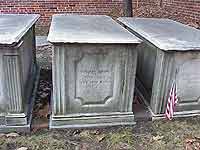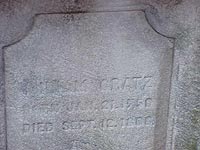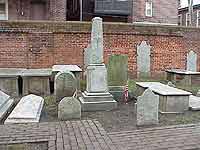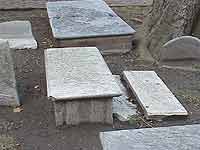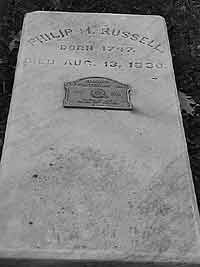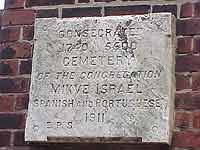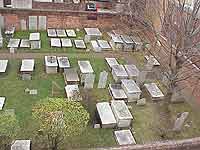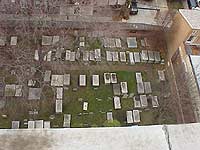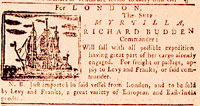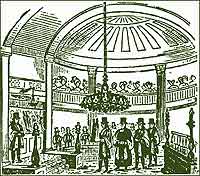
Mikveh Israel Cemetery
by Shirley Milgrim
Twenty-six years before William Penn, the Quaker leader who founded Philadelphia set foot in the New World in 1682, a few Jews were trading with the Native Americans along the South River of the New Netherlands (later known as the Delaware River). The commerce-minded Dutch had wrested this territory from the Swedes; and young Hebrews with official permission to travel and barter ventured south from Dutch-held New Amsterdam to scout new sources of furs.
The Jewish community in New Amsterdam numbered some two dozen souls who had first arrived in the trading post on the Hudson River in the autumn of 1654. Exiles from Brazil, they had gained permission to stay in Manhattan from the Dutch West India Company, sponsor of the colony. In time, a handful of adventurers from Jewish communities in Holland, London and Dutch-held islands of the Caribbean made their way to New Amsterdam. Some moved on to Newport, Rhode Island; others probed the South River area for commercial possibilities.
The British took New Amsterdam from the Dutch in 1655 and named it New York. Jewish fears that they might be restricted under the British were soon put to rest when the King decreed that all persons who behaved themselves were free to roam the British colonies.
On March 4, 1681, King Charles II of England signed the patent that granted William Penn, leader of the Quakers, land between New York and Maryland, west of the Delaware River. Penn informed the King he wished to embark on a "Holy Experiment": he would establish a "Great Towne," which he would name Philadelphia, the City of Brotherly Love. William Penn planned his colony carefully, and when he followed his agents to America in 1682, he found the most promising city in the colonies already rising. With its excellent outlet to the sea, its location about halfway between the northern and southern British colonies, and its strong-willed, able-bodied inhabitants already at work with hammer and nail, Philadelphia's success seemed assured.
Jewish trading agents from New York took note of how quickly houses, shops and taverns rose in Philadelphia; how the harbor on the Delaware berthed an ever-increasing number of sailing vessels from the West Indies and Europe; how the number of market stalls with produce from Mennonite farms outside the town multiplied; how the Lenni Lenape Indians, pelts slung over their shoulders, clustered where William Penn held sway, confident of fair treatment. Nor did the clamor for nails, tools and other supplies by the Scotch-Irish immigrants anxious to move westward and clear wilderness for themselves fall on deaf ears.
The reports of the traders brought New York merchants to Philadelphia. One of them was the New York-born son of Moses Levy, established merchant, active in the Jewish community of New York. In 1737, Nathan Levy settled permanently in Philadelphia where he built a business of his own. He and his cousin, David Franks, formed the first important Jewish company there, Levy and Franks, importers and merchants.
Nathan Levy had lived in his new home in Philadelphia less than a year when one of his children died. He appealed to William Penn's son, Thomas Penn, Chief of the Proprietary Government of Pennsylvania for a private place in which to bury his child. A pious Jew, he sought hallowed ground in which to bury his child in accordance with Jewish law.
Nathan Levy was allowed to buy a small plot on the north side of Walnut Street between Eighth and Ninth Streets, to be enclosed with a "fence of boards ... an area characterized by woortleberry bushes and cows grazing in open fields." In 1740, Nathan Levy established a permanent cemetery on Spruce Street between Eighth and Ninth which Thomas Penn ordered to be held in trust as a burial place for Hebrews. Benjamin Eastburn, the official surveyor of the Province, drew the plan for the site.
Oral history tells us that a group of Jews banded together to hold religious services in a rented house sometime in the mid-1700's. This group met for prayer and was probably joined on special occasions and the High Holy Days by Jewish travelers from Lancaster and other nearby towns. Although they did not establish a congregation in the formal sense until the 1770's, Congregation Mikveh Israel dates its beginning to the establishment of the cemetery in 1740. The cemetery is the oldest tangible evidence of Jewish communal life in Philadelphia.
The cemetery in 1740 was a 30' x 30' plot. In 1752, Nathan Levy received an additional grant of land north of the first plot. In1765, John Penn granted Mathias Bush, another member of Mikveh Israel, an adjacent piece of ground for burial purposes. Thus the area that the cemetery embraces today was completed. If you click at right for the surveyor's drawing, you will see that it covers an area fronting 60 ft. on the north side of Spruce Street and continuing 127 feet in depth to Manning Street. On the east side is Darien Street and Schell Street is on the west.
The appearance of the cemetery underwent several changes in the course of years. Nathan Levy enclosed it with a low brick wall in 1751 to protect the gravestones from "many unthinking people in the habit of setting marks and firing shots." Legend has it that when the British occupied Philadelphia in 1777, Redcoats would execute army deserters against the cemetery wall. In 1803 a new, higher wall replaced the one of colonial brick. Wrought-iron gates were added, and a sandstone marker erected telling of the cemetery's origin.
In 1791, Congregation Mikveh Israel appointed five trustees for the burial ground. A document of November 30, 1791, signed by David Franks reads:
"Whereas Nathan Levy..., — Merchant, did apply for two pieces of ground for a burial place for his family … this is to certify and declare that said application, which was in the name of the aforesaid Nathan Levy, was intended for the use of his family, and also for the use of the Hebrew Congregation (Mikveh Israel) of this City; it being intended at the time he applied for the same, to be a trust for a burial place for the internment of Hebrews."
This document records the right of Mikveh Israel to ownership of the Spruce Street Cemetery. It states the intent of Nathan Levy and Mathias Bush for the cemetery to be the resting place not only for their family members but for Jews in Philadelphia and beyond to be buried on sanctified ground in accordance with Jewish Law. Ownership was confirmed in 1828 by an act of the Pennsylvania Legislature.
Leaders of Mikveh Israel and their family members were buried in the cemetery on Spruce Street. Nathan Levy's tomb, dated 1753, bears the oldest decipherable inscription in the cemetery. The dates and the names, barely discernible on the weathered old tombstones, add dimensions today to the story of the emerging American nation.
Two plaques memorialize Haym Salomon, patriot and dedicated Jew. Born in Poland in 1740, he left Poland at the time of the Partition of 1772. He traveled in Europe for several years before immigrating to New York City around 1775. On the continent, he acquired mastery of European languages, currencies, and finance. In New York, he opened a brokerage and commission merchant's business. He was jailed in New York by the British as a spy and for participating in other revolutionary activities of the Sons of Liberty.
Salomon escaped to Philadelphia with his family. There he joined fellow Jews who had fled the British occupation. He established himself as a broker, selling currencies and notes at a discount. Robert Morris, Superintendent of the Office of Finance appointed Haym Salomon as official broker. From 1781 until1784, in this capacity, Salomon converted bills of exchange and foreign government notes into spendable cash at a low rate of interest for the highest obtainable price. The money was used to meet the urgent needs of the army, navy, and government
Solomon was known as "The Good Jew." In addition to his commitment to American Independence, Salomon devoted himself to Jewish affairs. A trustee of Congregation Mikveh Israel, he was the largest contributor to its first building, dedicated in 1782
The gravesite of Haym Salomon is unmarked. He is commemorated by a marble tablet on the east wall, installed by his great-grandson, William Salomon. A granite memorial is set inside the gate of the cemetery. Haym Solomon Lodge 663 of Brith Sholom contributed it and financed extensive repairs to the cemetery.
Haym Salomon died in 1785 at the age of 45. He left assets which barely covered his debts. The following obituary was printed in the Independent Gazetteer:
"Thursday, last, expired, after a lingering illness, Mr. Hyam Solomon, an eminent broker of this city, was a native of Poland, and of the Hebrew nation. He was remarkable for his skill and integrity in his profession, and for his generous and humane deportment. His remains were yesterday deposited in the burial ground of the synagogue of this city."
Aaron Levy (1742-1815}, a close friend and financial supporter of Haym Salomon, was a pioneer and fur trader. He founded of the town of Aaronsburg, Pennsylvania.
Rebecca Machado Phillips (1746-1831) was born to an eminent Portuguese Marrano family. She was the daughter of the David Mendoza Machado, Hazan (minister) of Congregation Shearith Israel of New York City. Her husband, Jonas Phillips, patriot and merchant, was a Parnas (president) of Congregation Mikveh Israel, as was her son, Zalegman Phillips, Esquire. She was very active in educational, social and philanthropic organizations and was mother to twenty one children. Among her eminent descendants are Commodore Uriah Phillips Levy and Mordechai Manuel Noah.
Michael Gratz (1740-1811) was Parnas of Mikveh Israel from 1784 to 1785. As a tribute to him and his wife Miriam, the northwestern section of the cemetery was reserved for the Gratz family. He arrived from Germany in 1758, following his older brother, Bernard, who was previously apprenticed to David Franks. Together they set up a coastal shipping service between New Orleans and Quebec. The French & Indian Wars interfered with shipping, and drove the brothers to western frontier trade in Pennsylvania, Illinois and Kentucky. They, along with David Franks, Mathias Bush and others, signed the Non-Importation Resolutions of 1765 to protest the Stamp Act. Later, the Gratz brothers supplied the Continental Army. During the British occupation of Philadelphia, the firm relocated to Lancaster, home of the father-in-law of Michael Gratz, Joseph Simon.
Michael and Miriam Gratz were the parents of twelve children. Among their children buried here are:
Jacob Gratz (1790-1856) served in the Pennsylvania House of Representatives and State Senate. Simon Gratz (1773-1839) and Hyman Gratz (1776-1857) inherited their father's business. Their store was at the Graff House (7th & Market) where Thomas Jefferson wrote the first draft of the Declaration of Independence. Both Simon and Hyman Gratz were treasurers of Mikveh Israel. They were among the founders of the Pennsylvania Academy of Fine Arts. Simon served in the Pennsylvania Volunteers during the war of 1812. Hyman was one of the managers of the first Jewish Publication Society, founded by Reverend Isaac Leeser in 1845. The will of Hyman Gratz established a trust fund for his descendants with the provision that after no descendants were living, the entire estate came into possession of Congregation Mikveh Israel "for a College for the Education of Jews." Gratz College, founded 1893, is now a separate institution in Melrose Park, Pennsylvania.
Rebecca Gratz (1781-1869) achieved renown as founder and officer of social and educational institutions managed by women. These organizations served as a model for others. They are the source of schools and social agencies in existence today. A bronze plaque in appreciation of her communal activities can be found at the cemetery
The Jewish soldiers of the Revolutionary War, the War of 1812 and the Civil War are interred in the burial grounds.
Phillip Moses Russell (1747-1830), a surgeon's mate, who received special commendation from General George Washington for his services at Valley Forge during the winters of 1777 and 1778.
Benjamin Nones (1757-1826), served on the staffs of both General Washington and General Lafayette. While still a private under Count Pulaski, he received a letter of commendation in 1779 written by Captain Verdier, a splendid testimonial to his courage. He fought in almost every action in the Carolinas. Nones became a Major of the Hebrew Legion of 400 men attached to DeKalb's command. Several years after the war, he was appointed an interpreter of Spanish and French for the United States government. Nones was Parnas of Mikveh Israel for 13 years over four different terms.
Reuben Etting (1762-1848), who enlisted in the Revolutionary Army at 19 years of age, suffered capture by the British at the surrender of Charleston. He was commissioned a captain of the Independent Blues in 1798 and was later appointed a United States Marshal for the State of Maryland by President Thomas Jefferson.
Four Minister/Rabbis from Congregation Mikveh Israel are buried in the cemetery. Their names and dates of tenure are:
- Reverend Jacob Raphael Cohen, 1784-1811
- Reverend Nunes Carvalho, 1815-1817
- Reverend Abraham Israel Keys, 1824-1828
- Reverend Leon Elmaleh, 1898-1927, emeritus 1927-1972
Reverend Jacob Raphael Cohen celebrated the ratification of the United States Constitution by walking hand-in-hand in the procession with Reverend William White of Christ Church, the dean of Philadelphia's clergy.
The cemetery ceased to be a regular place of burial in 1886 except for the interment of Josephine Etting in 1913, Fanny Polano Elmaleh, wife of Reverend Leon H. Elmaleh, in 1966 and Reverend Leon H. Elmaleh in 1972.
In July 1953, an Ordinance was introduced in the City Council of Philadelphia establishing the Mikveh Israel Cemetery as a historic shrine. Since 1956, Mikveh Israel Cemetery has been designated a National Historic Shrine. The late congressman James Byrnes, in whose district the burial ground is located, introduced in the House of Representatives a bill to make the Spruce Street Cemetery and Christ Church, located at Second and Market Streets, where Washington worshipped, national historic sites. On July 23, 1956, the House passed the bill.
In January 1956, a hearing was held in Washington, DC concerning a proposed Federal Bill to make the historic burial ground a part of Independence National Historic Park. A campaign, spearheaded by "The Jewish Times", was instrumental in bringing about the designation. The Senate and House of Representatives passed the bill. On August 6th, 1956, President Eisenhower signed the bill into law.
Those involved in the designation were Congressmen James Byrne, Earl Chudoff, Hugh Scott, Jr., and William Barrett. Additional advocates of the bill were Esther Klein, Publisher and Editor of "The Jewish Times", Philip Klein, President of Harcum Junior College and the Junto Adult School; Reverend Leon H. Elmaleh, Rabbi Emeritus, Reverend Alan Corre, Rabbi, Gustave Klein, President and Isidor Ostroff, Esq., Board Member.
Ellen and Joseph Bunford Samuel gave service to the upkeep of the grounds. They provided restoration of the wall and a new gate. Mrs. Samuel was the great-granddaughter of Rebecca Machado Phillips.
In 1971, the Jewish Cemetery Association of Greater Philadelphia worked with the officers of the congregation to have the cemetery placed on the National Register of Historic Places. It was added at the same time that Christ Church (Episcopal) and the cathedral of Sts. Peter and Paul (Roman Catholic) were admitted to the list.
During the decade of the sixties and the first five years of the seventies, grass and trees were trimmed when funds and manpower were made available by Jewish war veteran groups and the Haym Salomon Lodge 663 of Brith Sholom.
In 1975, in anticipation of the national Bicentennial Celebration and an influx of visitors to one of the most important concentrations of historic buildings and sites in the United States, the Colonial Philadelphia Historical Society, a non-ethnic organization, volunteered its services to the Congregation Mikveh Israel and the National Park Service to restore and maintain Philadelphia's earliest Jewish cemetery. The offer was gratefully accepted.
In 1980, the Colonial Philadelphia Historical Society established the Mikveh Israel Cemetery Trust to provide for the perpetual upkeep of Mikveh Israel Cemetery.
"The Story of Mikveh Israel Cemetery" was edited by the Archives Staff of Congregation Mikveh Israel using the following references:
- L.H. Elmaleh and J. Bunford Samuel, "The Jewish Cemetery: Ninth and Spruce Streets, Philadelphia" (1906, Revised 1962).
- Edwin Wolf, II and Maxwell Whiteman, "The History of the Jews of Philadelphia from Colonial Times to the Age of Jackson" (1957)
- Edwin Wolf, II and Maxwell Whiteman, "Haym Salomon: The Patriotic Money Manipulator," Philadelphia Inquirer (1976)
- "The Universal Jewish Encyclopedia," 1941, Volume V, Gratz Family.
8th & Spruce Streets, Philadelphia, PA
Founded in 1740
June 19 to August 13, 2004
Sunday, Tuesday, Wednesday, Thursday, Friday, 10am–3pm
Also open Monday July 4
Guided tours under auspices of Mikveh Israel Cemetery Trust, Jordan Peiper, Guide
A National Shrine Part of Independence National Historical Park
If you would like information about a historical figure interred in the cemetery or want to bring a group, please call the synagogue office at 215-922-5446 to arrange a special tour.
Mikveh Israel • 44 N. Fourth Street • Philadelphia, PA 19106 • 215-922-5446
Rabbi Albert E. Gabbai, Minister • Leon L. Levy, Parnas/President

